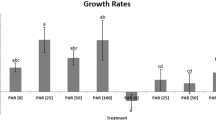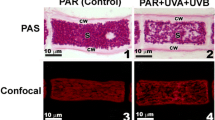Abstract
Microcoleus chthonoplastes constitutes one of the dominant microorganisms in intertidal microbial mat communities. In the laboratory, the effects of repeated daily exposure to ultraviolet radiation (16:8 light:dark cycle) was investigated in unicyanobacterial cultures isolated from three different localities (Baltic Sea = WW6; North Sea = STO and Brittany = BRE). Photosynthesis and growth were measured in time series (12–15 days) while UV-absorbing mycosporine-like amino acids (MAAs) and cellular integrity were determined after 12 and 3 days exposure to three radiation treatments [PAR (22 μmol photon m−2 s−1) = P; PAR + UV-A (8 W m−2) = PA; PAR + UV-A + UV-B (0.4 W m−2) = PAB]. Isolate-specific responses to UVR were observed. The proximate response to radiation stress after 1-day treatment showed that isolate WW6 was the most sensitive to UVR. However, repeated exposure to radiation stress indicated that photosynthetic efficiency (Fv/Fm) of WW6 acclimated to UVR. Conversely, although photosynthesis in STO exhibited lower reduction in Fv/Fm during the first day, the values declined over time. The BRE isolate was the most tolerant to radiation stress with the lowest reduction in Fv/Fm sustained over time. While photosynthetic efficiencies of different isolates were able to acclimate to UVR, growth did not. The discrepancy seems to be due to the higher cell density used for photosynthesis compared to the growth measurement. Apparently, the cell density used for photosynthesis was not high enough to offer self-shading protection because cellular damage was also observed in those filaments under UVR. Most likely, the UVR acclimation of photosynthesis reflects predominantly the performance of the surviving cells within the filaments. Different strategies were observed in MAAs synthesis. Total MAAs content in WW6 was not significantly different between all the radiation treatments. In contrast, the additional fluence of UV-A and UV-B significantly increased MAAs synthesis and accumulation in STO while only UV-B fluence significantly increased MAAs content in BRE. Regardless of the dynamic photosynthetic recovery process and potential UV-protective functions of MAAs, cellular investigation showed that UV-B significantly contributed to an increased cell mortality in single filaments. In their natural mat habitat, M. chthonoplastes benefits from closely associated cyanobacteria which are highly UVR-tolerant due to the production of the extracellular UV-sunscreen scytonemin.





Similar content being viewed by others
Abbreviations
- Chl a :
-
Chlorophyll a
- MAAs:
-
Mycosporine-like amino acids
- PAR:
-
Photosynthetically active radiation
- UVR:
-
Ultraviolet radiation
References
Bancroff BA, Baker NJ, Blaustein AR (2007) Effects of UVB radiation of marine and freshwater organisms: a synthesis through meta-analysis. Ecol Lett 10:332–345
Bebout BM, Garcia-Pichel F (1995) UV B-induced vertical migrations of cyanobacteria in a microbial mat. Appl Environ Microbiol 61:4215–4222
Bischof K, Peralta G, Kraebs G, van de Poll WH, Perez-Llorens JL, Breeman AM (2002) Effects of solar UV-B radiation on canopy structure of Ulva communities from southern Spain. J Exp Bot 53:2411–2421
Carreto JI, Carignan MO, Montoya NG (2005) A high-resolution reverse-phase liquid chromatography method for the analysis of mycosporine-like amino acids (MAAs) in marine organisms. Mar Biol 146:237–252
Castenholz RW (1997) Multiple strategies for UV tolerance in cyanobacteria. Spectrum 10:10–16
Castenholz RW, Garcia-Pichel F (2000) Cyanobacterial responses to UV-radiation. In: Whitton BA, Potts M (eds) Ecology of cyanobacteria. Their diversity in time and space. Kluwer, Dordrecht, pp 591–611
Cockell CS, Knowland J (1999) Ultraviolet radiation screening compounds. Biol Rev 74:311–345
Day TA (2001) Ultraviolet radiation and plant ecosystems. In: Cockell CS, Blaustein AR (eds) Ecosystems, evolution, and ultraviolet radiation. Springer, Heidelberg, pp 80–117
De Nys R, Steinberg PD (2002) Linking marine biology and biotechnology. Curr Opin Biotechnol 13:24–248
Decho AW (2000) Microbial biofilms in intertidal systems: an overview. Cont Shelf Res 20:1257–1273
Edge R, Mc Garvey DJ, Truscott TG (1997) The caroteniods as antioxidants: a review. J Photochem Photobiol B: Biol 41:189–200
Ehling-Schulz M, Bilger W, Scherer S (1997) UV-B induced synthesis of photoprotective pigments and extracellular polysaccharides in the terrestrial cyanobacterium Nostoc commune. J Bacteriol 179:1940–1945
Fleischmann EM (1989) The measurement and penetration of ultraviolet radiation into tropical marine water. Limnol Oceanogr 34:1623–1629
Garcia-Pichel F (1994) A model for internal self-shading in planktonic organisms and its implications for the usefulness of ultraviolet sunscreens. Limnol Oceanogr 39:1704–1717
Garcia-Pichel F, Castenholz RW (1993) Occurrence of UV-absorbing, mycosporine-like compounds among cyanobacterial isolates and an estimate of their screening capacity. Appl Environ Microbiol 59:163–169
Garcia-Pichel F, Sherry ND, Castenholz RW (1992) Evidence for a UV-sunscreen role of the extracellular pigment scytonemin in the terrestrial cyanobacterium Chlorogloeopsis sp. Photochem Photobiol 56:17–23
Garcia-Pichel F, Bebout PL, Muyzer G (1996) Phenotypic and phylogenetic analysis show Microcoleous chthonoplastes to be a cosmopolitan cyanobacterium. Appl Environ Microbiol 62:3284–3291
Häder D-P, Kumar HD, Smith RC, Worrest RC (2007) Effects of solar UV radiation on aquatic ecosystems and interactions with climatic change. Photochem Photobiol Sci 6:267–285
He Yu-Ying, Häder D-P (2002) UV-B-induced formation of reactive oxygen species and oxidative damage of the cyanobacterium Anabaena sp.: protective effects of ascorbic acid and N-acetyl-l-cysteine. J Photochem Photobiol B Biol 66:115–124
Helbling EW, Gao K, Ai H, Ma Z, Villafane VE (2006) Differential responses of Nostoc sphaeroides and Arthrospira platensis to solar ultraviolet radiation exposure. J Appl Phycol 18:57–66
Ivanov AG, Miskiewicz E, Clarke AK, Greenberg BM, Huner NPA (2000) Protection of photosystem II against UV-A and UV-B radiation in the cyanobacterium Plectonema boryanum: the role of growth temperature and growth irradiance. Photochem Photobiol 72:772–779
Karsten U (1996) Growth and organic osmolytes of geographically different isolates of Microcoleus chthonoplastes (cyanobacteria) from benthic microbial mats: response to salinity change. J Phycol 32:501–506
Karsten U (2002) Effects of salinity and ultraviolet radiation on the concentration of mycosporine-like amino acids in various isolates of the benthic cyanobacterium Microcoleus chthonoplastes. Phycol Res 50:129–134
Karsten U, Garcia-Pichel F (1996) Carotenoids and mycosporine-like amino acids compounds in members of the genus Microcoleus (cyanobacteria): a chemosystematic study. Appl Microbiol 19:285–294
Karsten U, Wiencke C, Kirst GO (1991) The effect of salinity changes upon the physiology of eulittoral green macroalgae from Antarctica and Southern Chile. J Exp Bot 42:1533–1539
Karsten U, Klimant I, Holst G (1996) A new in vivo fluorimetric technique to measure growth of adhering phototrophic microorganisms. Appl Environ Microbiol 62:237–243
Karsten U, Sawall T, Wiencke C (1998a) A survey of the distribution of UV-absorbing substances in tropical macroalgae. Phycol Res 46:271–279
Karsten U, Maier J, Garcia-Pichel F (1998b) Seasonality in UV-absorbing compounds of cyanobacterial mat communities from an intertidal mangrove flat. Aquat Microbiol Ecol 16:37–44
Karsten U, Lembcke S, Schumann R (2007) The effects of ultraviolet radiation on photosynthetic performance, growth and sunscreen compounds in aeroterrestrial biofilm algae isolated from building facades. Planta 225:991–1000
Kerfeld AC (2004) Water-soluble carotenoid proteins of cyanobacteria. Arch Biochem Biophys 430:2–9
Kruschell C, Castenholz RW (1998) The effect of solar UV and visible irradiance on the vertical movements of cyanobacteria in microbial mats of hypersaline waters. FEMS Microbiol Ecol 27:53–72
Nadeau TL, Williams CH, Catenholz RW (1999) Effects of solar UV and visible irradiance on photosynthesis and vertical migration of Oscillatoria sp. (cyanobacteria) in an Antarctic microbial mat. Aquat Microbiol Ecol 20:231–243
Neale PJ, Banaszak AT, Jarriel CR (1998) Ultraviolet sunscreens in Gymnodinium sanguineum (Dinophyceae): mycosporine-like amino acids protect against inhibition of photosynthesis. J Phycol 34:928–938
Paterson DM (1994) Microbial mediation of sediment structure and behaviour. In: Stal LJ, Caumette P (eds) Microbial mats-structure, development and environmental significance. NATO ASI Series, vol 35. Springer, Berlin, pp 97–110
Pattanaik B, Adhikary SP (2004) Effects of UV-B irradiation on survival, spectral characteristics and nitrogenase activity of cyanobacteria from different habitats. Algol Stud 113:159–173
Pattanaik B, Sahu JK, Adhikary SP (2004) Changes in the protein profile of cyanobacteria from terrestrial habitats in response to heat and UV-B radiation stress. Algol Stud 113:175–182
Pattanaik B, Schumann R, Karsten U (2007) Effects of ultraviolet radiation on cyanobacteria and their protective mechanisms. In: Seckbach J (ed) Cellular origin, life in extreme habitats and astrobiology: algae and cyanobacteria in extreme environments. (COLE) Book Series, vol 11. Springer, Netherlands, pp 29–45
Portwich A, Garcia-Pichel F (1999) Ultraviolet and osmotic stresses induce and regulate the synthesis of mycosporines in the cyanobacterium Chlorogloeopsis PCC 6912. Arch Microbiol 172:187–192
Potts M (1994) Desiccation tolerance of prokaryotes. MicrobRev 58:755–805
Prufert-Bebout L, Garcia-Pichel F (1994) Field and cultivated Microcoleus chthonoplastes: the search for clues to its prevalence in marine microbial mats. In: Stal LJ, Caumette P (eds) Microbial mats-structure, development and environmental significance. NATO ASI Series, vol 35. Springer, Berlin, pp 111–116
Quesada A, Vincent WF (1997) Strategies of adaptation by Antarctic cyanobacteria to ultraviolet radiation. Eur J Phycol 32:335–342
Roleda MY, van de Poll WH, Hanelt D, Wiencke C (2004a) PAR and UVBR effects on photosynthesis, viability, growth and DNA in different life stages of two coexisting Gigartinales: implications for recruitment and zonation pattern. Mar Ecol Prog Ser 281:37–50
Roleda MY, Hanelt D, Kräbs G, Wiencke C (2004b) Morphology, growth, photosynthesis and pigments in Laminaria ochroleuca (Laminariales, Phaeophyta) under ultraviolet radiation. Phycologia 43:603–613
Roleda MY, Clayton MN, Wiencke C (2006) Screening capacity of UV-absorbing compounds in spores of Arctic Laminariales. J Exp Mar Biol Ecol 338:123–133
Schoenwaelder MEA (2002) Physode distribution and the effect of ‘thallus sunborn’in Hermosira banksii (Fucales, Pheaophyceae). Bot Mar 45:262–266
Shirkly B, Kovarcik D-P, Wright DJ, Wilmoth G, Prickett TF, Helm RF, Gregory EM, Potts M (2000) Active Fe-containing superoxide dismutase and abundant sodF mRNA in Nostoc commune (cyanobacteria) after years of desiccation. J Bacteriol 182:189–197
Sinha RP, Ambasht NK, Sinha JP, Klisch M, Häder D-P (2003) UV-B induced synthesis of mycosporine-like amino acids in three strains of Nodularia (cyanobacteria). J Photochem Photobiol B Biol 71:51–58
Stal LJ (1995) Physiological ecology of cyanobacteria in microbial mats and other communities. New Phytol 131:1–32
Starr R, Zeikus J (1987) UTEX-the culture collection of algae at the University of Texas at Austin. J Phycol (Suppl) 23:1–47
Vincent WF, Quesada A (1994) Ultraviolet radiation effects on cyanobacteria: implications for Antarctic microbial ecosystem. In: Weiler CS, Penhale PA (eds) Ultraviolet radiation in Antarctica: measurements and biological effects Antarctic research series, vol 62. American Geophysical Union, Washington, pp 111–124
Wachi Y, Burgess JG, Iwamoto K, Yamada N, Nakamura N, Matsunaga T (1995) Effect of ultraviolet-A (UV-A) light on growth, photosynthetic activity and production of biopterin glucoside by the marine UV-A resistant cyanobacterium Oscillatoria sp. Biochem Biophysics Acta 1244:165–168
Wu H, Gao K, Villafane V, Watanabe T, Helbling EW (2005) Effects of solar UV radiation on morphology and photosynthesis of filamentous cyanobacterium Arthrospira platensis. Appl Environ Microbiol 71:5004–5013
Wulff A, Mohlin M, Sundbäck K (2007) Intraspecific variation in the response of the cyanobacterium Nodularia spumigena to moderate UV-B radiation. Harmful Algae 6:388–399
Acknowledgments
We thank S. Lembcke, S. Görs and L. Gustavs for excellent technical support with HPLC and laboratory assistance. BP thanks Boehringer Ingelheim Fonds (BIF), Germany for the research scholarship grant and the Swedish Institute for the current fellowship. UK gratefully acknowledges financial support by the Deutsche Forschungsgemeinschaft (DFG).
Author information
Authors and Affiliations
Corresponding author
Rights and permissions
About this article
Cite this article
Pattanaik, B., Roleda, M.Y., Schumann, R. et al. Isolate-specific effects of ultraviolet radiation on photosynthesis, growth and mycosporine-like amino acids in the microbial mat-forming cyanobacterium Microcoleus chthonoplastes . Planta 227, 907–916 (2008). https://doi.org/10.1007/s00425-007-0666-0
Received:
Accepted:
Published:
Issue Date:
DOI: https://doi.org/10.1007/s00425-007-0666-0




